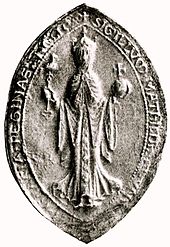One of the other benefits of Henry being a very different person from William is that Anselm of Bec was able to resume his position at Canterbury as archbishop. Unfortunately, although Henry asked Anselm back and was going to give him all the states connected to Canterbury, he did ask Anselm to do him homage, and wanted to invest him (again) with the ring and crozier of his station. This would have meant that the king had authority to invest an archbishop, to which Anselm immediately refused. Henry even asked permission for this from Pope Paschal II, but Paschal would not grant it for the same reason that Anselm refused it.
Not everything between Anselm and Henry was hostile. Anselm supported Henry against his brother, Robert Curthose, who asserted a claim to England. Anselm also supported Henry's deposing of the Bishop of Durham, Ranulph (Ralph) Flambard, who was responsible for some of the corruption of William's administration. (Flambard was the first person to be imprisoned in the Tower of London, as well as the first person ever to escape. I told that story here.)
Anselm also supported Henry in his desire to marry Matilda of Scotland (illustration), despite Matilda's status as a nun(!). At a different council, however, Anselm established the Gregorian reforms, prohibiting marriage, concubinage, and drunkenness among clerics. He also regulated clerical dress and condemned the British slave trade. Henry supported Anselm's reforms, but still asserted that he had authority over Anselm himself. Henry dispatched three bishops to Rome to get the pope's approval for his authority, and upon their return claimed that the pope had given it. Anselm decided to travel to Rome himself to verify this, along with William Warelwast whom he had sent to Rome earlier. Upon learning of the king's deception, Pope Paschal excommunicated the three bishops who had lied for Henry.
When word of the pope's actions reached Henry, he sent a message to Anselm, telling him not to return to England. In this second exile, Anselm decided it was time to go on the offensive. He made Henry an offer he dare not refuse. I'll explain tomorrow.





